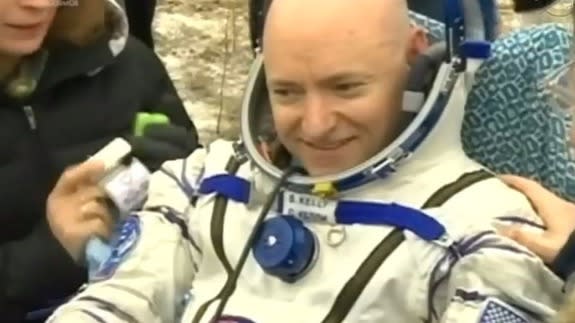NASA astronaut Scott Kelly returns to Earth after 340 days in space

NASA astronaut Scott Kelly is back on Earth after a record-setting 340 consecutive days in space, the most in NASA's history.
The space explorer landed in Kazakhstan at 11:26 p.m. ET on March 1 after spending nearly a full year on the International Space Station in an effort to understand how the human body responds to long periods of weightlessness.
SEE ALSO: This astronaut just spent 340 days in space. Here's why it was worth it.
Kelly returned to Earth with his fellow yearlong mission crewmember, Russian cosmonaut Mikhail Kornienko, and cosmonaut Sergey Volkov in their Russian-built Soyuz spacecraft.

Image: NASA
“They did it," NASA spokesman Rob Navias said. "They’re home after a year in space, and they stuck the landing."
Kelly and Korienko launched to the station on March 27, 2015.

Image: NASA
Goodbye to the Space Station
The trio of space explorers came back home on March 1 — just shy of a full year in space — partially because of the orbital mechanics needed to get the three crew members back to the ground safely, NASA spokesman Dan Huot said.
"Essentially there are specific dates where the station and therefore the Soyuz will cross over specific parts of the Earth (Kazakhstan) which allow you to line up for the usual landing and recovery zones," Huot told Mashable via email.
For his part, Kelly doesn't mind that he wasn't on orbit for a full 365 days.
"If I launched in March and land in March, that's pretty close to a year," Kelly said during an in-flight news conference before the landing. "So, no, I'm not slightly disappointed at all, actually. It is actually something I haven't really considered."

Image: NASA TV
Leaving the Space Station also meant that Kelly needed to say goodbye to his off-world home for what may be the last time.
The record-holding astronaut also flew to orbit on three previous flights, one of which was for a more typical six-month mission aboard the Space Station.
This yearlong mission bring's Kelly's total time in space to 520 days, more than any U.S. astronaut to date.
"Leaving this amazing facility is going to be tough, because I probably will never see it again," Kelly said. "I've flown in space four times now so it's going to be hard in that respect ... I've been up here for a really long time and sometimes, when I think about it, I feel like I've lived my whole life up here."
Kelly will be greeted back in Houston, Texas Wednesday by Dr. Jill Biden, Vice President Joe Biden's wife, NASA administrator Charlie Bolden and John Holdren, Assistant to the President for Science and Technology.
Kelly's identical twin brother Mark Kelly and his wife, former congresswoman Gabby Giffords, will also be there with other members of his family to meet the returned astronaut.
The science of a yearlong mission
And now that Kornienko and Kelly are back on Earth, the real scientific fun can begin.
The two Space Station crewmembers will now be put through their physical paces before ever leaving the landing zone in Kazakhstan.
"We go through about an hour of what is called this 'field test' that is various different types of experiments," Kelly said.
"Some are physical — kind of like even an obstacle course, where you run around obstacles and stand up from a sitting position and jump and stand — that looks at the ability of our physiology to adjust to those different positions."
That kind of data is immensely important for scientists on Earth.
The whole point of Kornienko and Kelly's mission has been to gather more information about how the human body behaves during and after a year in space. This information is important because NASA eventually wants to send humans to Mars, a round trip mission that could take more than a year.
By testing the crew members' agility just after landing, researchers should get at least some sense of what a Mars-exploring astronaut may experience when feeling the gravity of the red planet for the first time after a long journey in weightlessness.
If NASA scientists can figure out how the body changes during an extended period in space, they may be able to come up with ways to mitigate any harmful side effects of space travel like bone density loss or radiation exposure.


